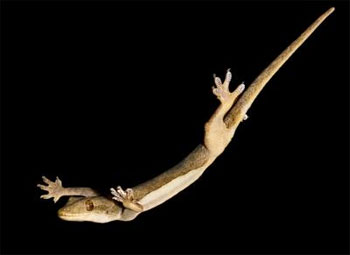New research uncovers the super-tail of the gecko
According to new research the gecko may have the most dynamic tail in the natural world. Two researchers from UC Berkley have discovered that the gecko uses its tail to keep itself from falling off slippery vertical surfaces and when falling to rapidly right itself. So, like a cat, it always lands on four feet.
Geckos have long been known for their remarkable feet, which sport specialized toes with millions of microscopic hairs ending in spatulae, allowing the gecko to climb completely vertical surfaces. But only now have scientist’s discovered how the tail plays into the geckos ability to climb the seemingly impossible. The scientists tested the geckos on slippery vertical surfaces and found that when the lizard loses its grip it presses its tail to the wall to keep itself from slipping. The gecko could fall back as much as 60 degrees and still manage to right itself using its tail. “When we ran all of our geckos on perfect surfaces, they never slipped, and they didn’t use their tails,” Dr. Robert J. Full said, “but when we put in a slippery patch, we found that they have an active tail that functions like a fifth leg to keep them from tipping backward. This is an undiscovered function for tails that tells us a lot about how active tails could affect the performance of vertebrates.” Dr. Full, professor of integrative biology at UC Berkeley, compares the most extreme of these tail-movements to a bicycle kickstand.
 his photo of a flat-tailed house gecko skydiving in a wind tunnel was selected for the cover of the March 18, 2008, issue of PNAS. Geckos use their fat-filled tail to right themselves in midair and maneuver to a secure perch. Credit: Robert Full/UC Berkeley, copyright PNAS/NAS 2008. |
High-speed video was required to see the tail in action, since the movement occurs in milliseconds. Incredibly fast lizards, geckos can travel up vertical surfaces three feet per second, taking 30 full steps each second.
The gecko’s tail was found to have another unique use. The same researchers tested the gecko’s response to falling from high surfaces and found that the tail was just as vital here as it was in climbing. In freefall the gecko rotates its tail to maneuver itself so that it will fall always feet first—such a maneuver taking only a tenth of a second. Once righted it then spreads its legs and toes to create what scientists call a parachuting effect. This is completely different from the way in which cats right themselves in mid-fall. “Air righting in mammals is characterized by a bending and twisting of the spine,” UC Berkeley graduate student Ardian Jusufi said. “The gecko is keeping its limbs and spine absolutely immobile in nearly 70 percent of all trials, and only rotates its tail until it turns around.” Furthermore, once righted, a gecko will use its tail as steering device; the scientists compared such freefall corrections to skydivers hitting a target. Dr. Full speculated that “in the wild, this might allow a gecko escaping a predator to just go off the end of a branch and maneuver to another place.” Jusufi is currently studying geckos in the wild in pursuit of this very idea.
Scientists hope to use this new research for creating robots with ‘active tails’ like that of the gecko. The research could also apply to the creation of better unmanned vehicles or spacecraft, and may even be used in designing astronaut suits. Dr. Full believes the discovery to be an “example of how basic research leads to unexpected applications – new climbing and gliding robots, highly maneuverable unmanned aerial vehicles and even energy-efficient control in space vehicles.”
The study focused mostly on the Flat-tailed House Gecko, Cosymbotus platyurus. There are well over a thousand species of gecko known across the globe, many of which are highly endangered, often due to habitat destruction and the introduction of non-native species, such as rats and cats, which prey on them.
Ardian Jusufi, Daniel I. Goldman, Shai Revzen, and Robert J. Full (2008). Active tails enhance arboreal acrobatics in geckos,” PNAS March 21, 2008